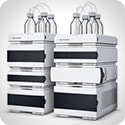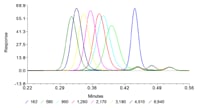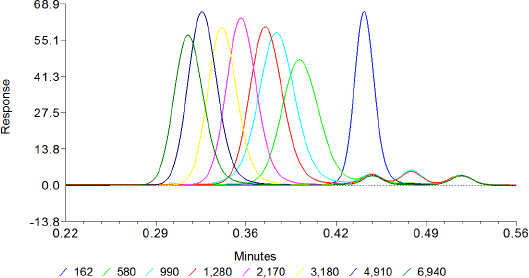Access Agilent eNewsletter, July 2014
>> Update My Profile | Subscribe to Access Agilent | Article Directory

Fast size exclusion chromatography for 2D HPLC with Agilent Columns
By Joe Kiefer and Matthias Pursch
The Dow Chemical Company
Stephen Luke
Agilent GPC Column Product Manager
Characterization of complex polymers sometimes involves the application of two-dimensional high pressure liquid chromatography (2D HPLC). The first dimension often uses enthalpic conditions for elution, based on functional groups, polymer chain ends, or polymer chain composition. When size and/or molecular weight data are also required, size exclusion chromatography (SEC) is employed in the second dimension, due to the isocratic conditions. Like any 2D HPLC analysis, the second dimension needs to be very fast – an SEC separation of one minute or less is desirable.
 Enlarge
Enlarge
Figure 1. Individual polystyrene standards on an Agilent PLgel MIXED-E, 10 x 50 mm column (6 mL/min, 〜0.5 mg/mL, eluent HPLC grade THF, UV detection at 260 nm).
Use shorter, wider columns for fast SEC
Resolution in SEC is based on total pore volume. To achieve SEC separation in one minute or less, shorter columns and higher flow rates would be needed, compared to conventional separations using 300 mm length columns at 1 mL/min. In this article, we examine the performance of 50 and 100 mm length columns from Agilent. These columns are also wider bore, 10 mm compared to conventional 7.8 mm, which offers more pore volume and allows higher flow rates to be used. Since the columns have 3 µm particles and elution volumes are not small, HPLC equipment with low dead volumes or high pressure capability are not needed. Figure 1 shows the separation of a range of polystyrene standards on an Agilent PLgel MIXED-E, 10 x 50 mm column.
Increase speed 20-fold
As captured in Figure 1, we achieved run times of less than one minute, whereas the same separation on the longer column took 20 minutes. Calculated number, weight, and z-average molecular weight values were within 10% compared to traditional two-column, 20-minute run times. Although loss of resolution for the low molecular oligomer region was observed for a low molecular synthetic blend, the fractions from the intended 2D HPLC analysis are expected to be larger in molecular weight.
Table 1 shows the molecular weight information obtained from both the 20 minute and fast SEC separations.
Agilent PLgel dimensions |
Mn (g/mole) |
Mw (g/mole) |
Mz (g/mole) |
Mz+1 (g/mole) |
Mn |
Mw |
Mz |
|---|---|---|---|---|---|---|---|
10 x 50 mm |
1.369 |
2.938 |
4.957 |
6.517 |
0.91 |
1.01 |
1.09 |
7.5 x 600 mm |
1.509 |
2.912 |
4.562 |
5.732 |
|
|
|
Table 1. Comparison of molecular weight distributions derived from 10 x 50 mm and 7.5 x 600 mm versions of the Agilent PLgel MIXED-E column.
High efficiency columns provide fast separations
In this example we demonstrated that short, wide-bore columns packed with high efficiency 3 µm particles provide very fast SEC separations, with adequate resolution for use in the characterization of complex polymers via 2D HPLC.
These very fast separations can be achieved using conventional HPLC instruments, such as the Agilent 1290 Infinity 2D-LC. This easy-to-use 2D solution delivers the highest separation power for most complex separation problems by combining two orthogonal separations into one run. Take a moment to learn more about the Agilent portfolio of GPC/SEC columns and calibration standards today. Then reserve your copy of the Agilent 2D-LC primer, available Summer 2014.
>> Update My Profile | Subscribe to Access Agilent | Article Directory
